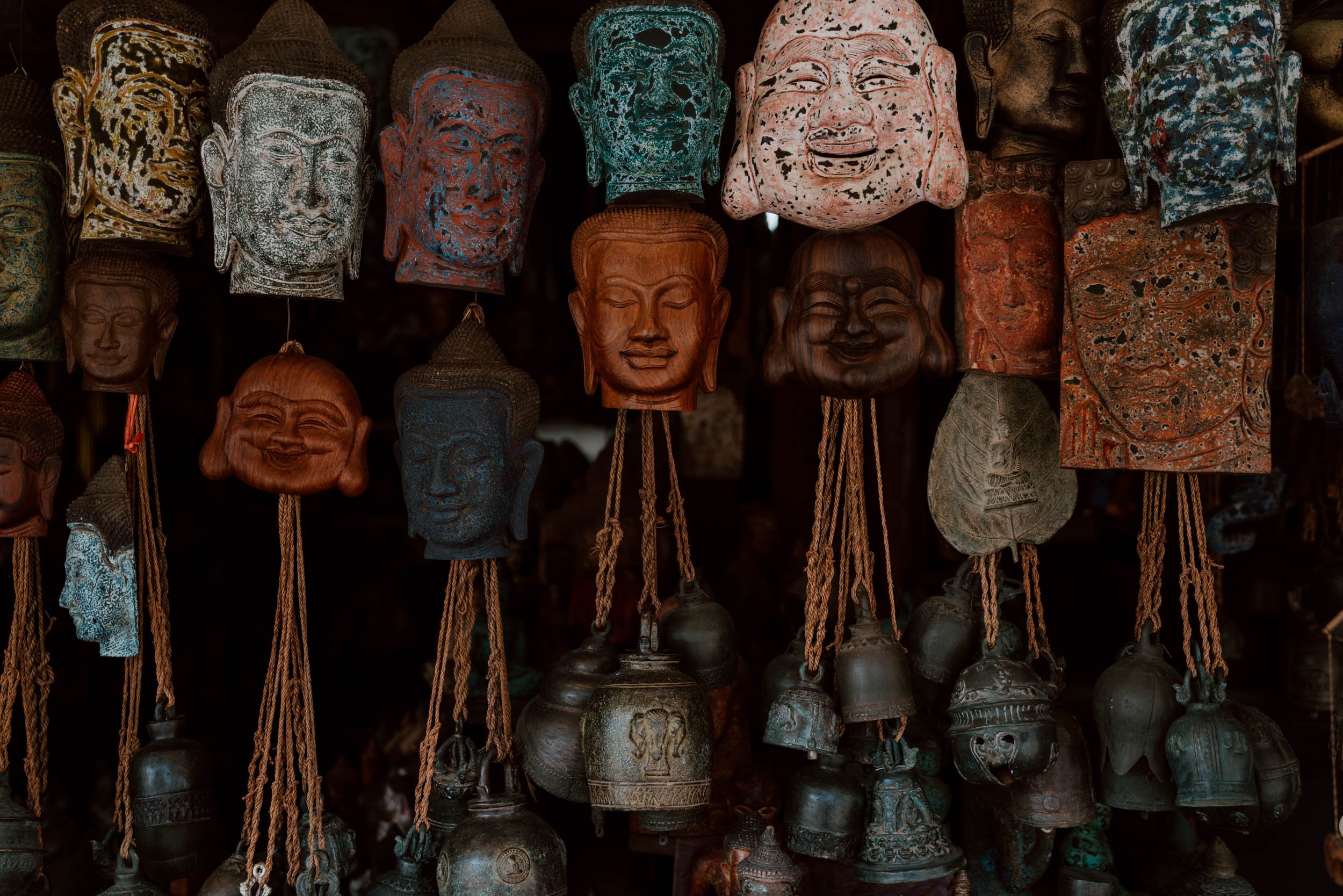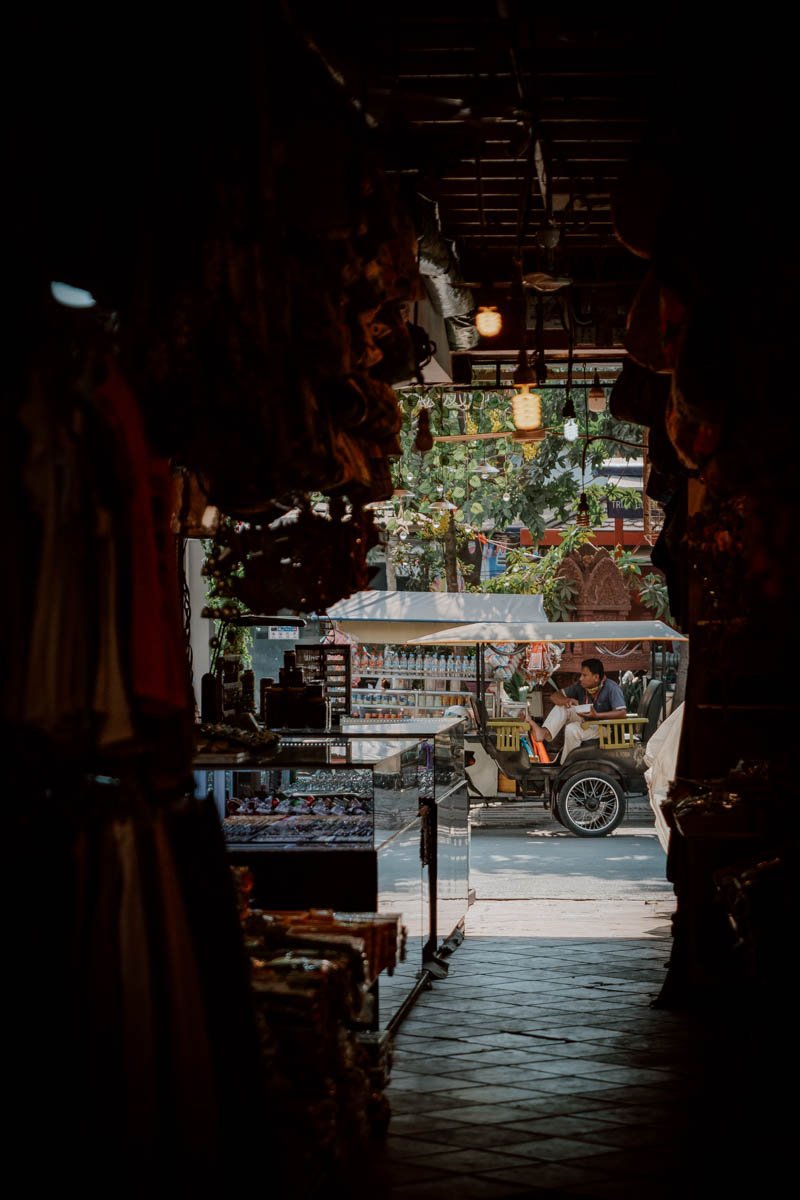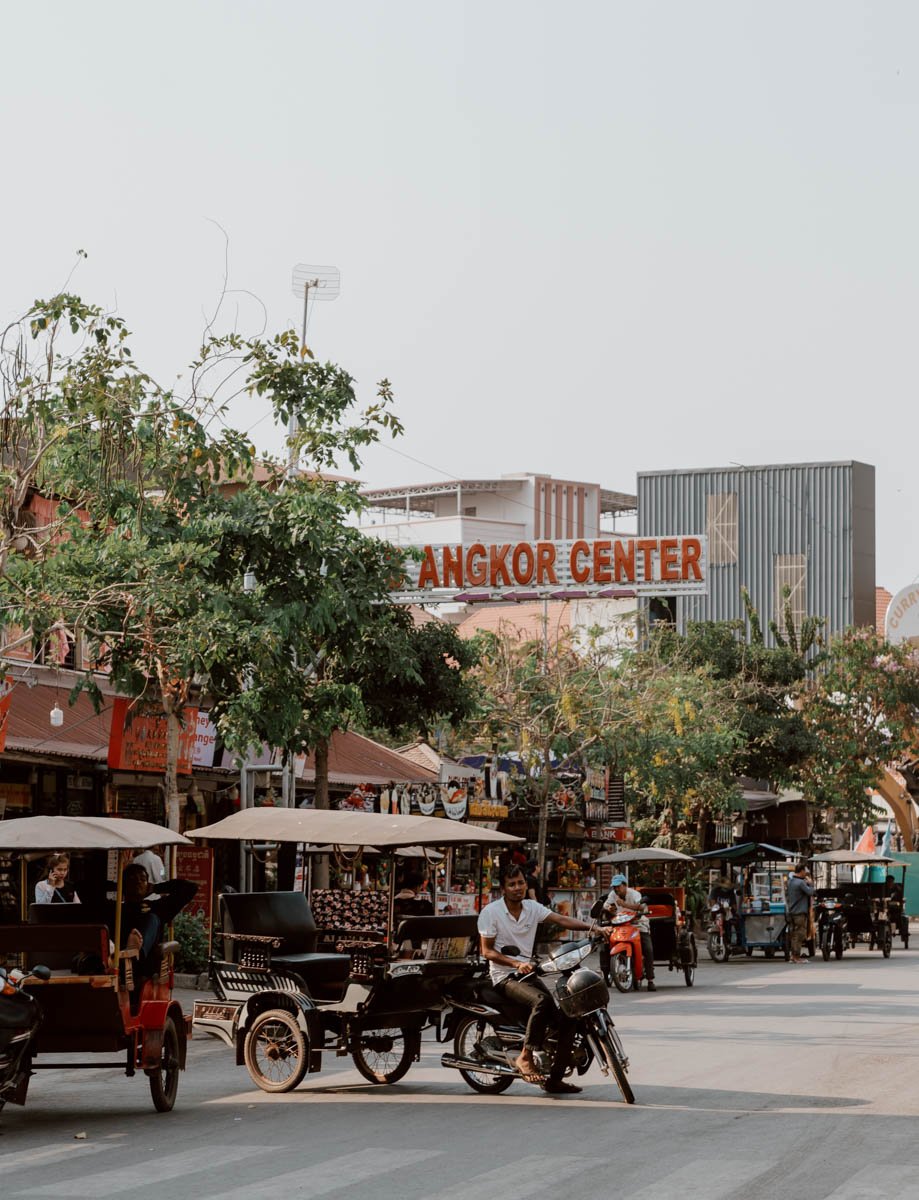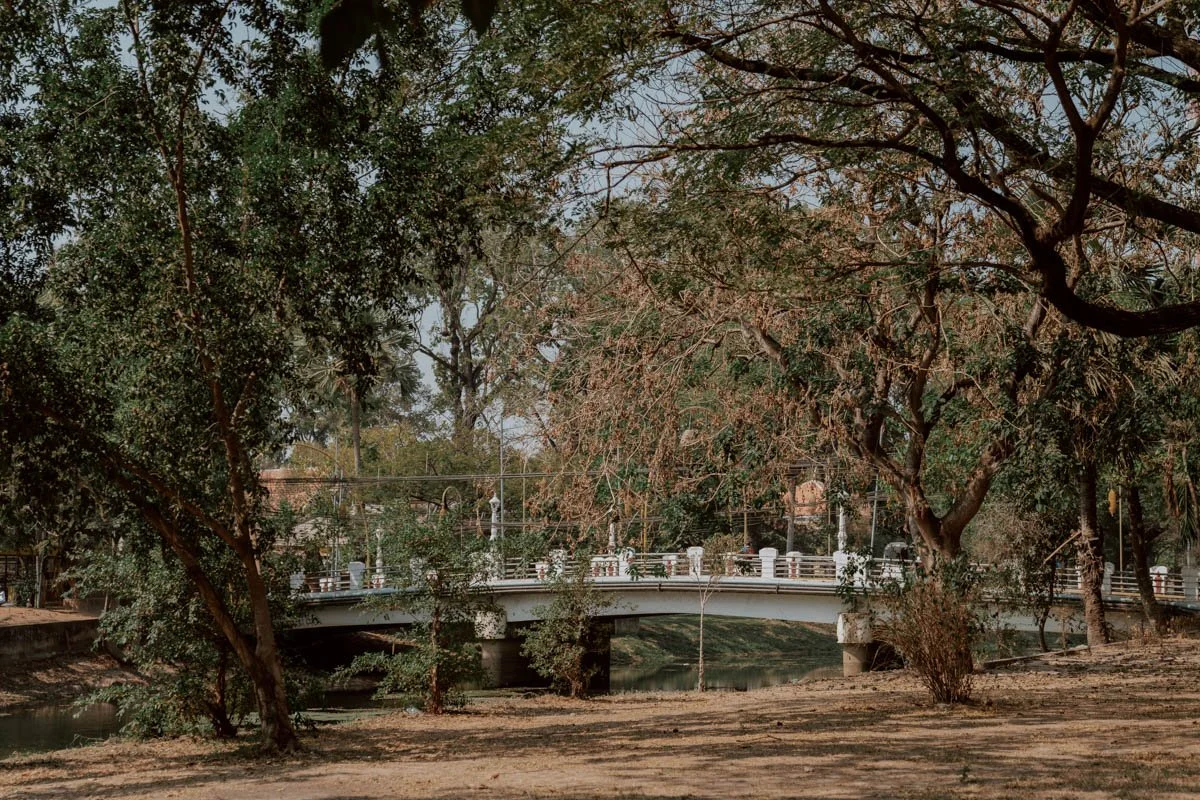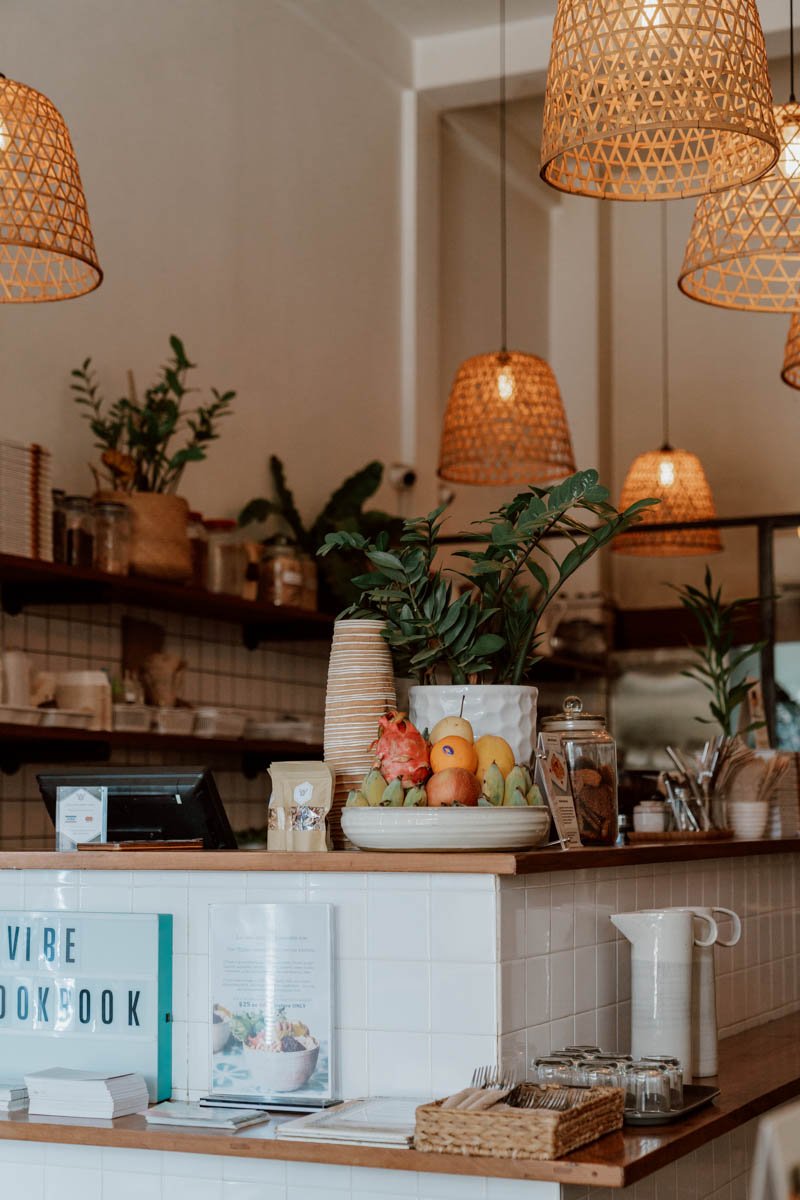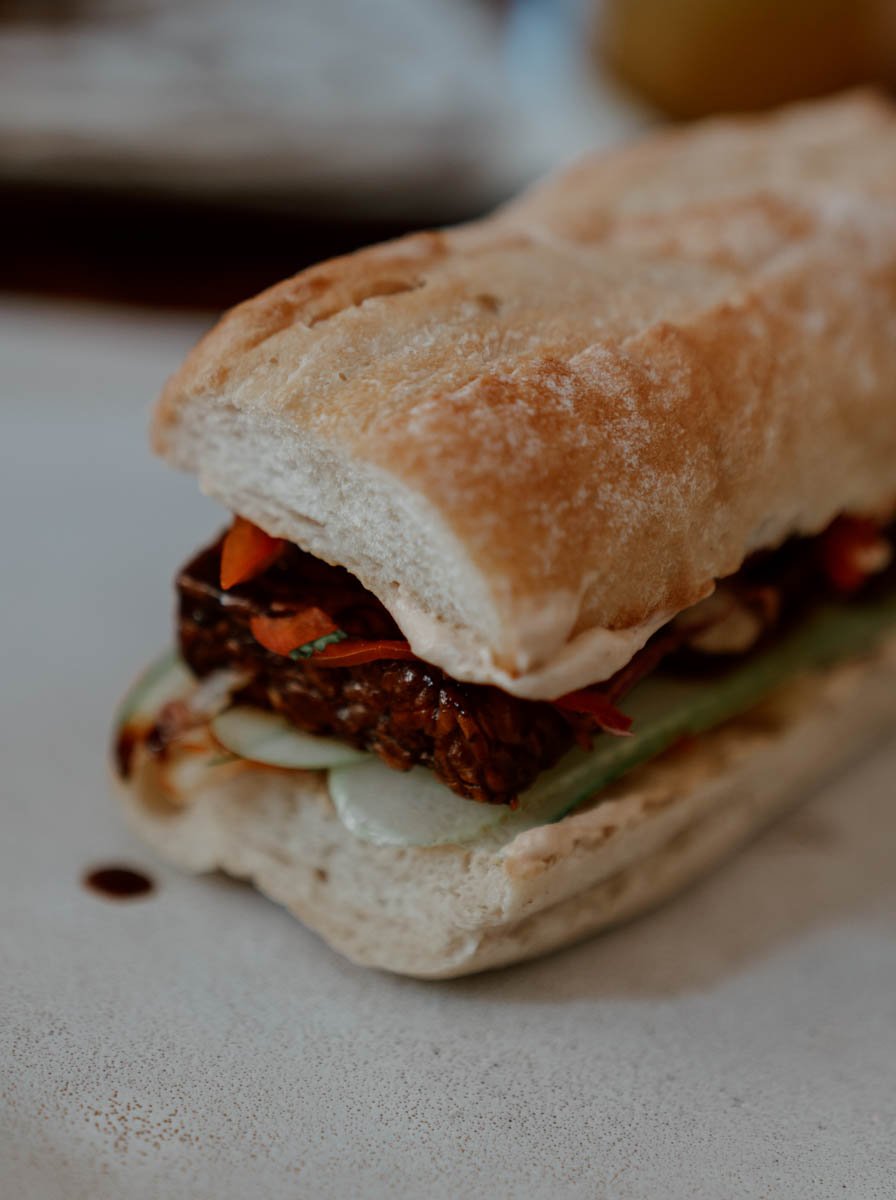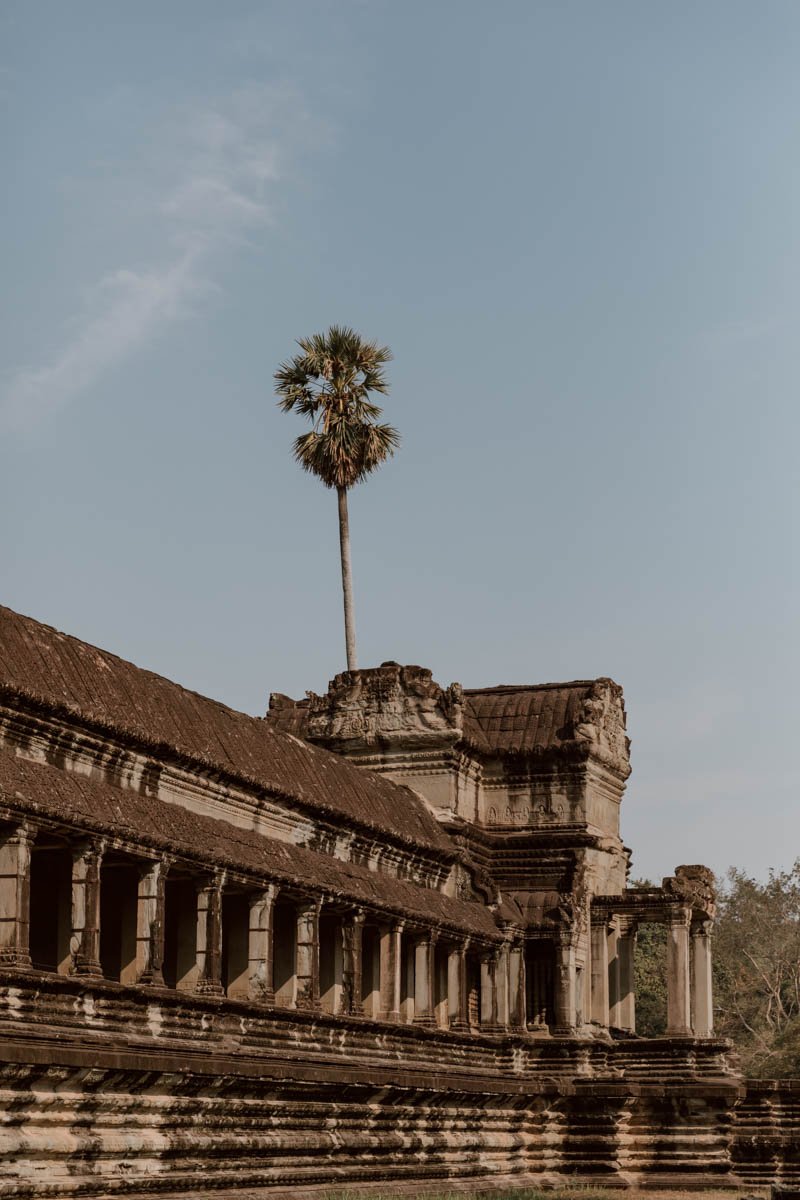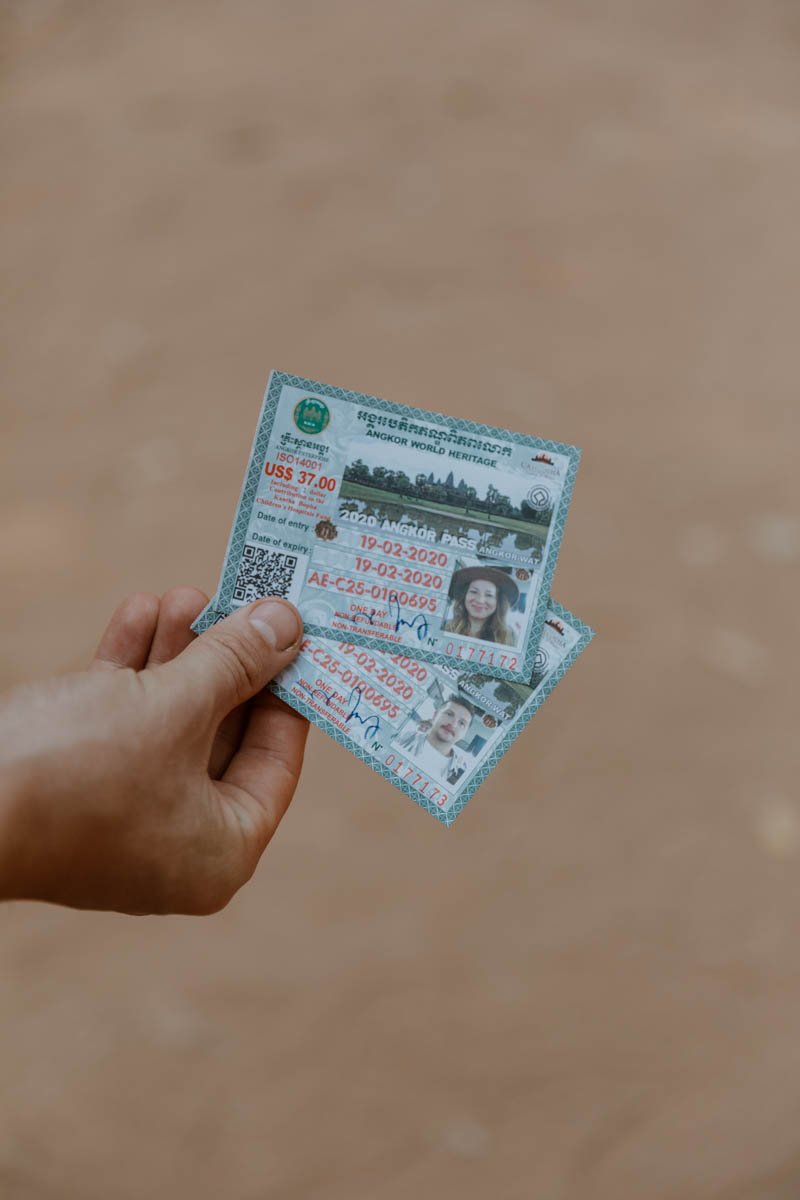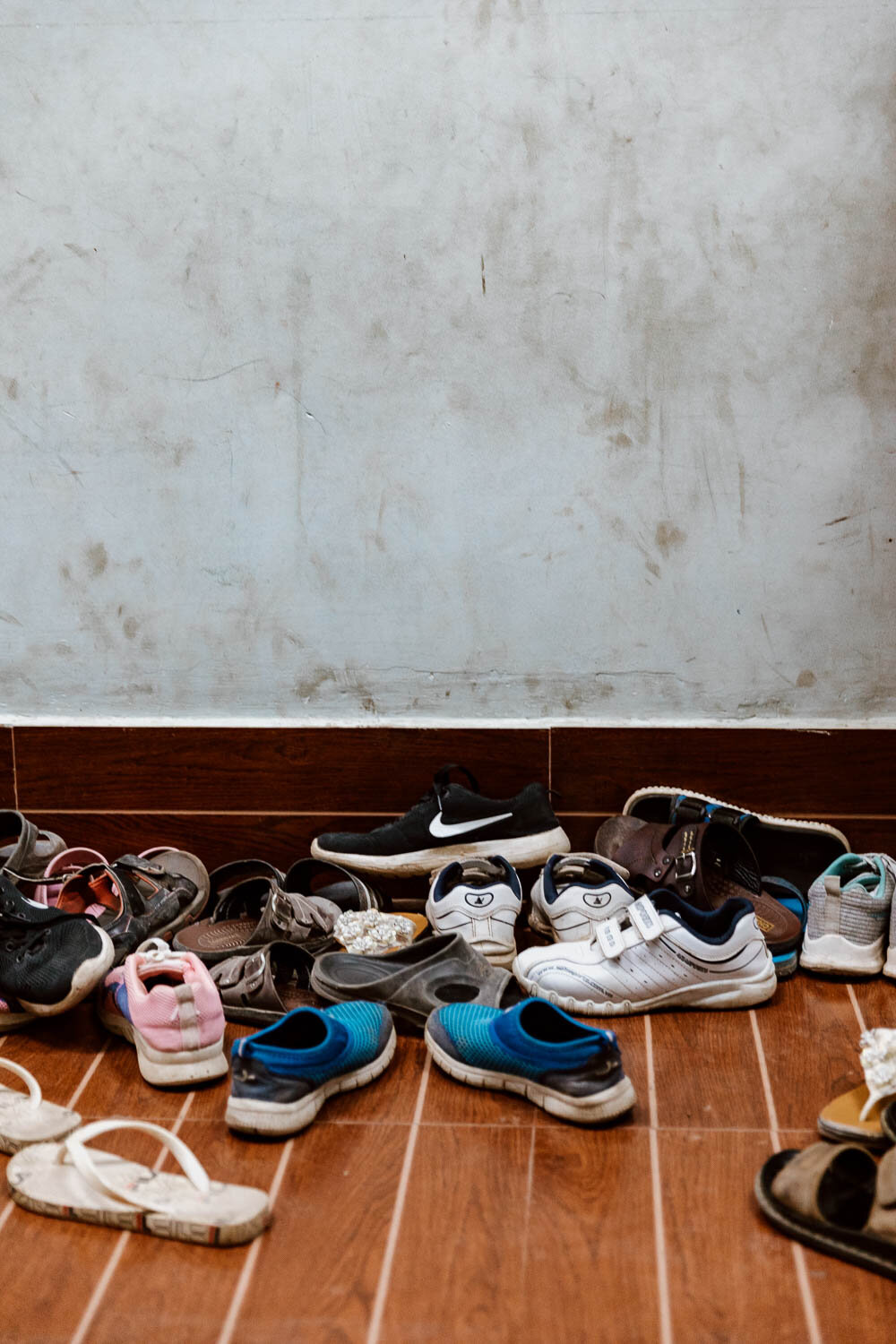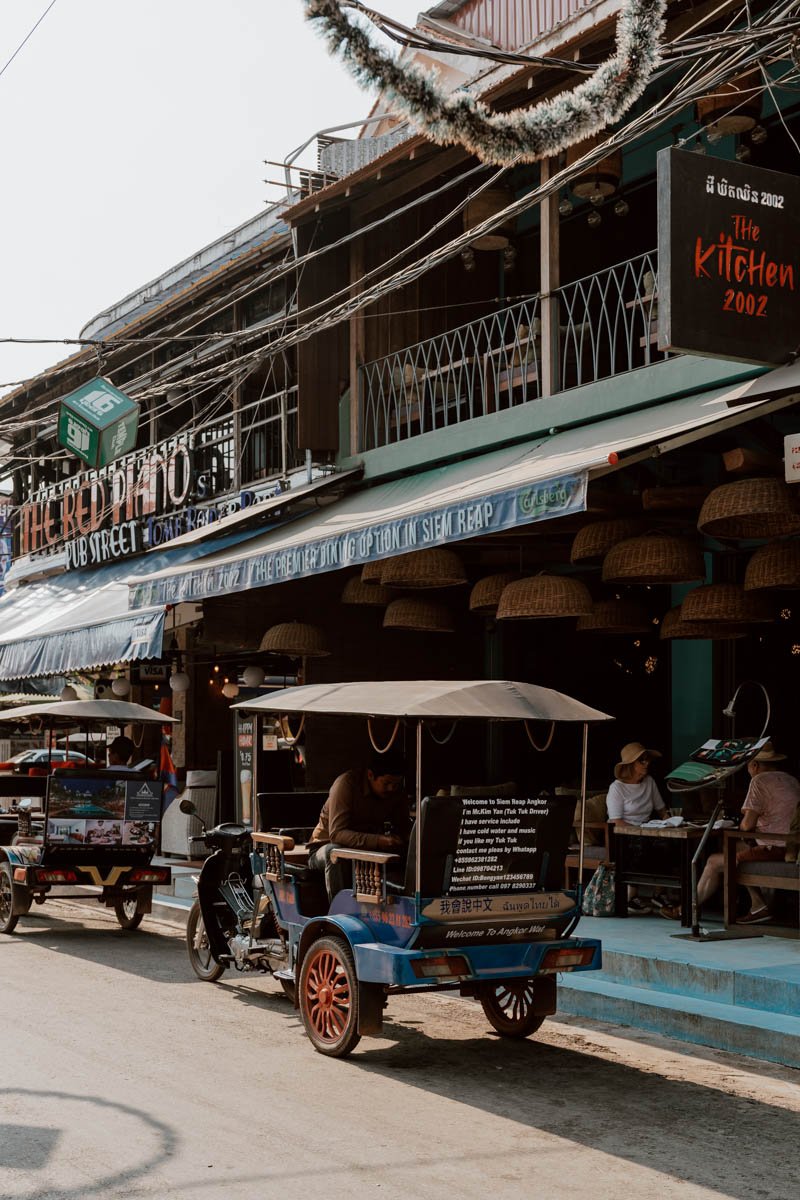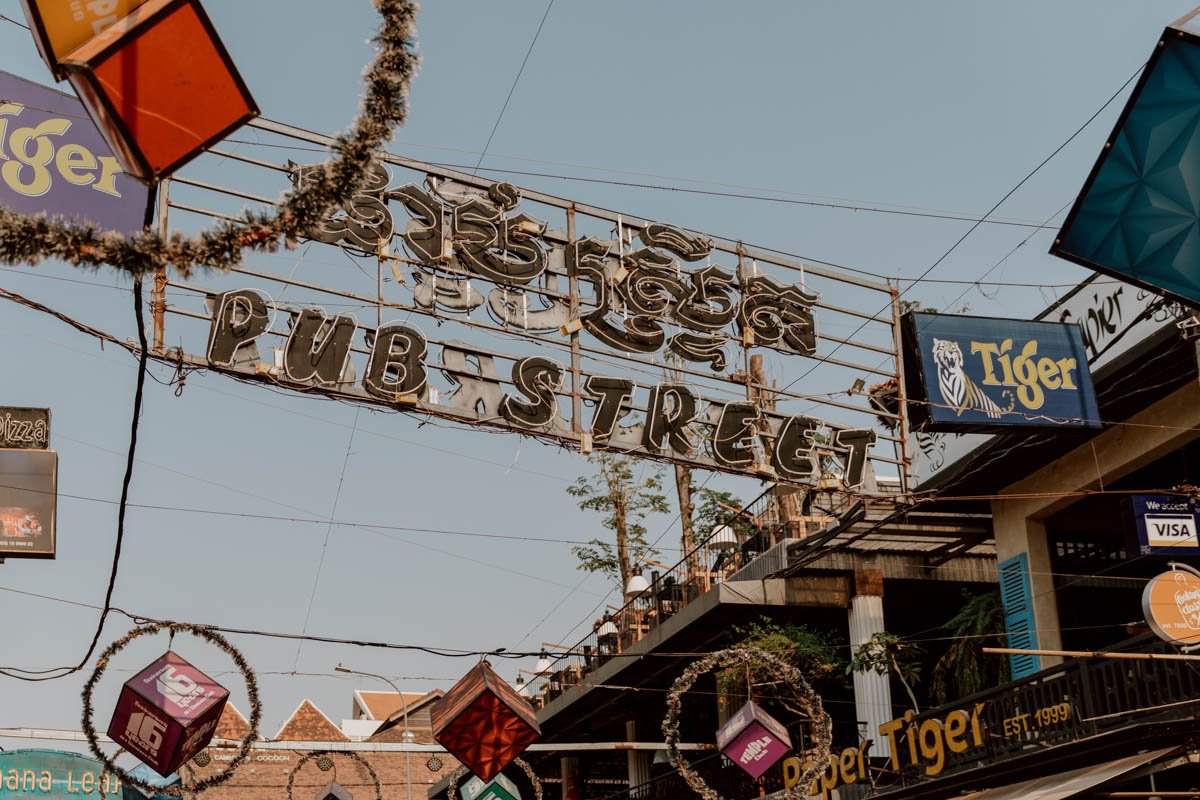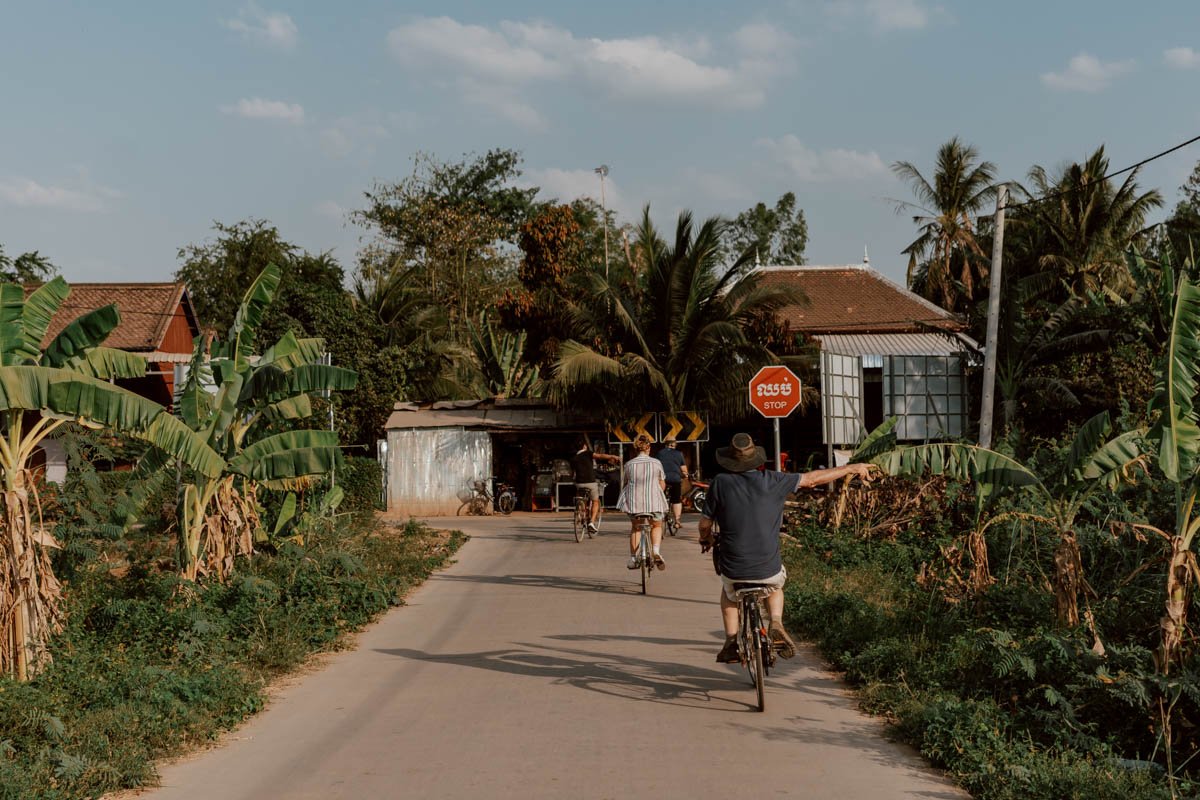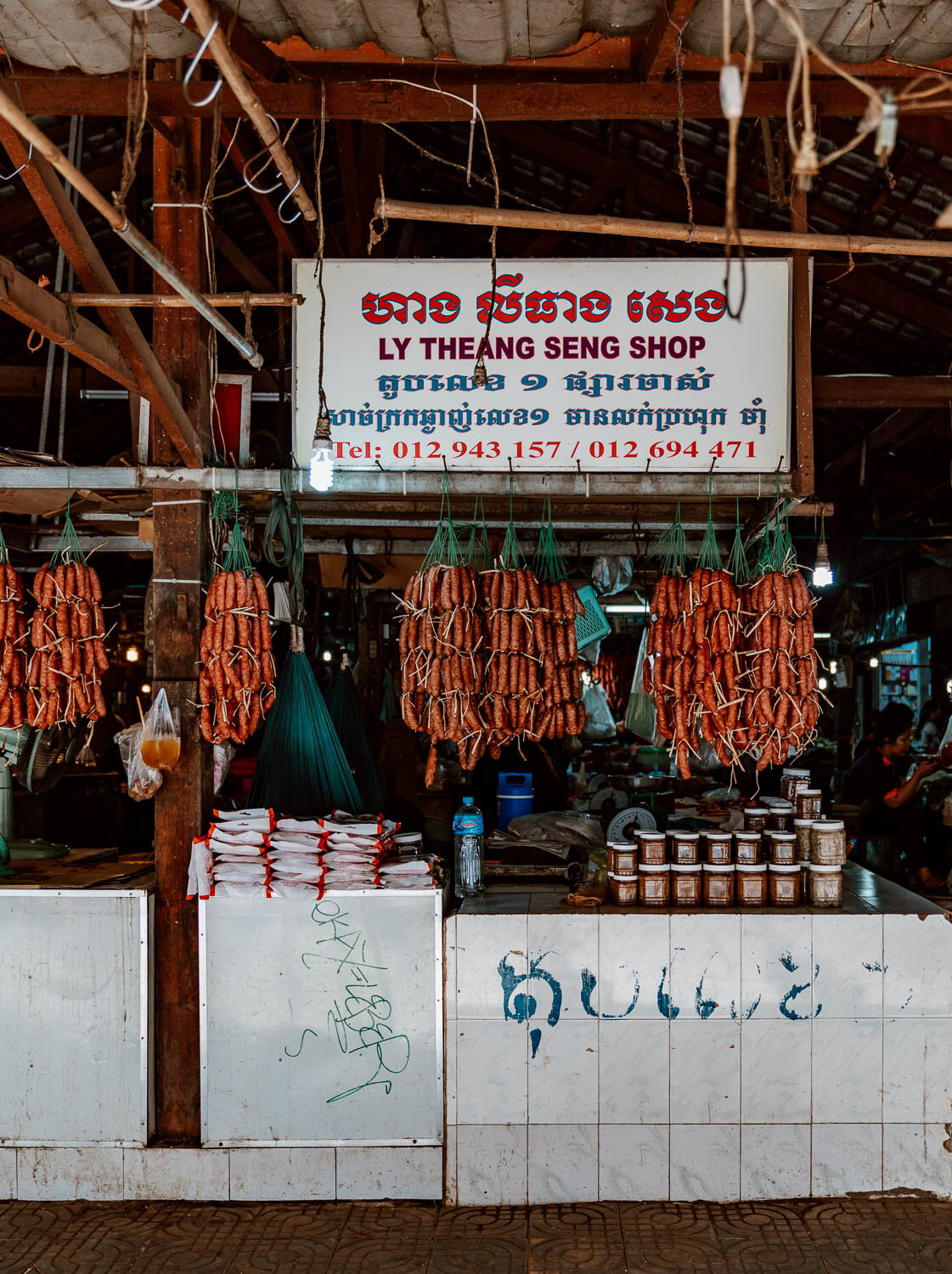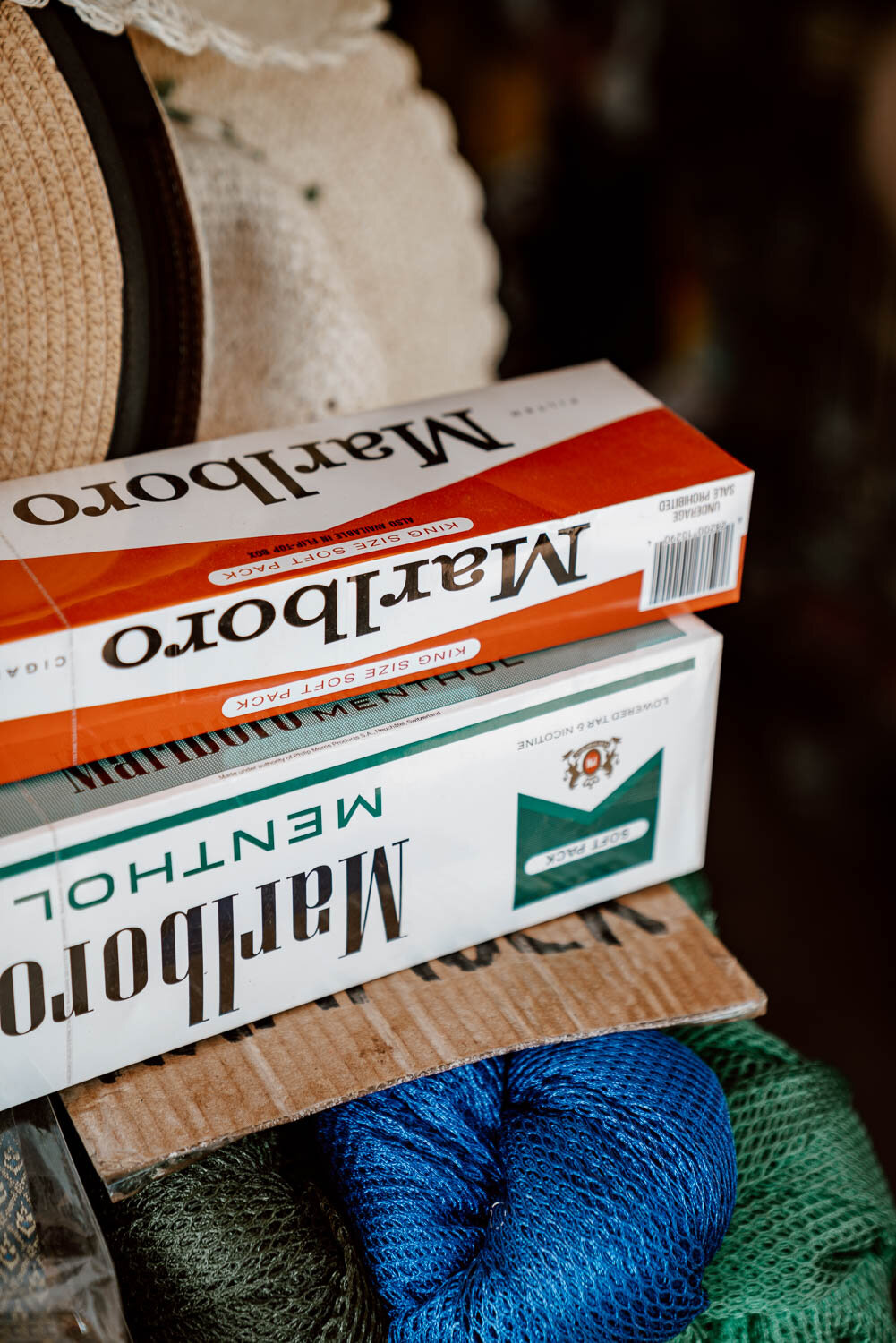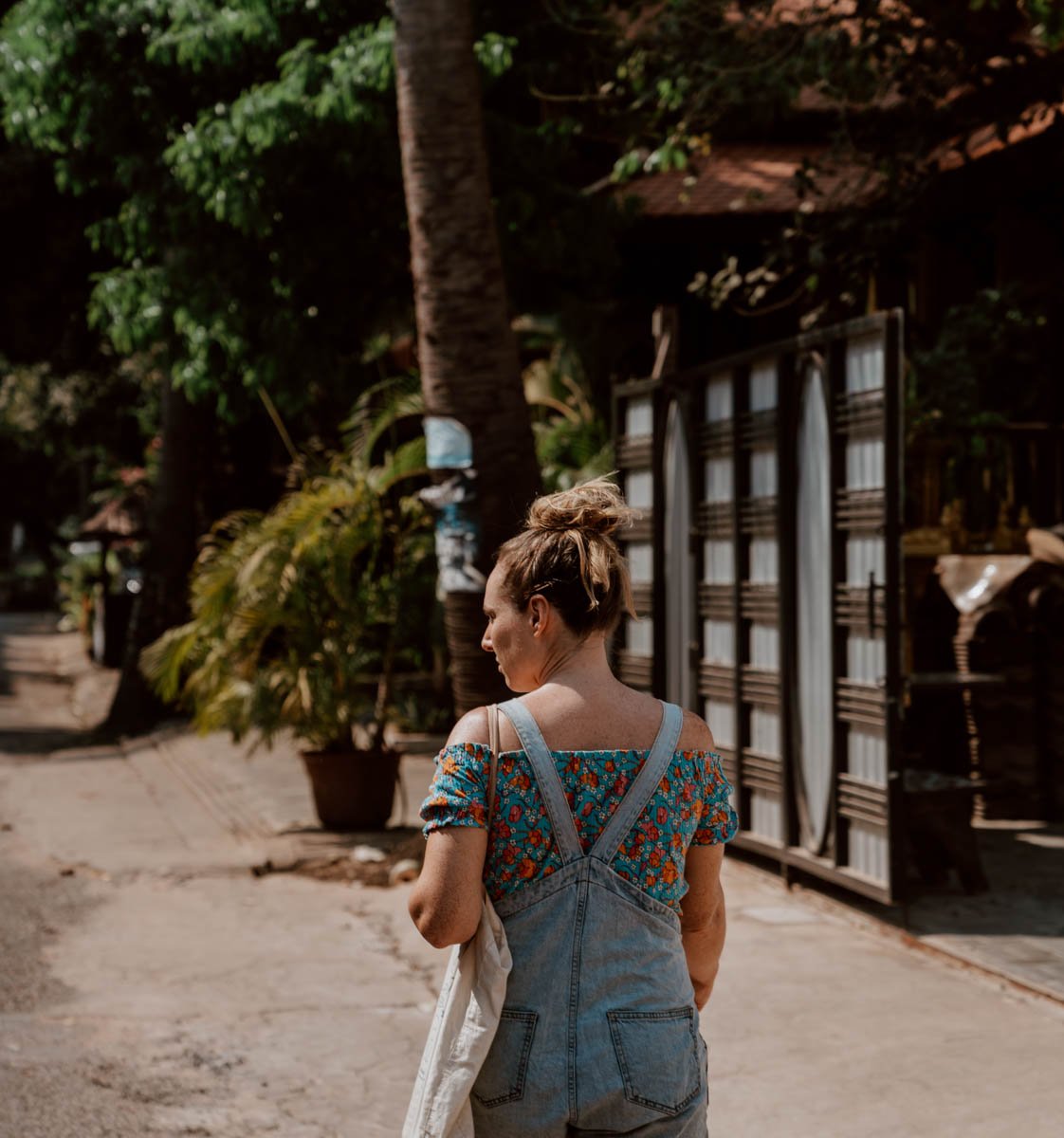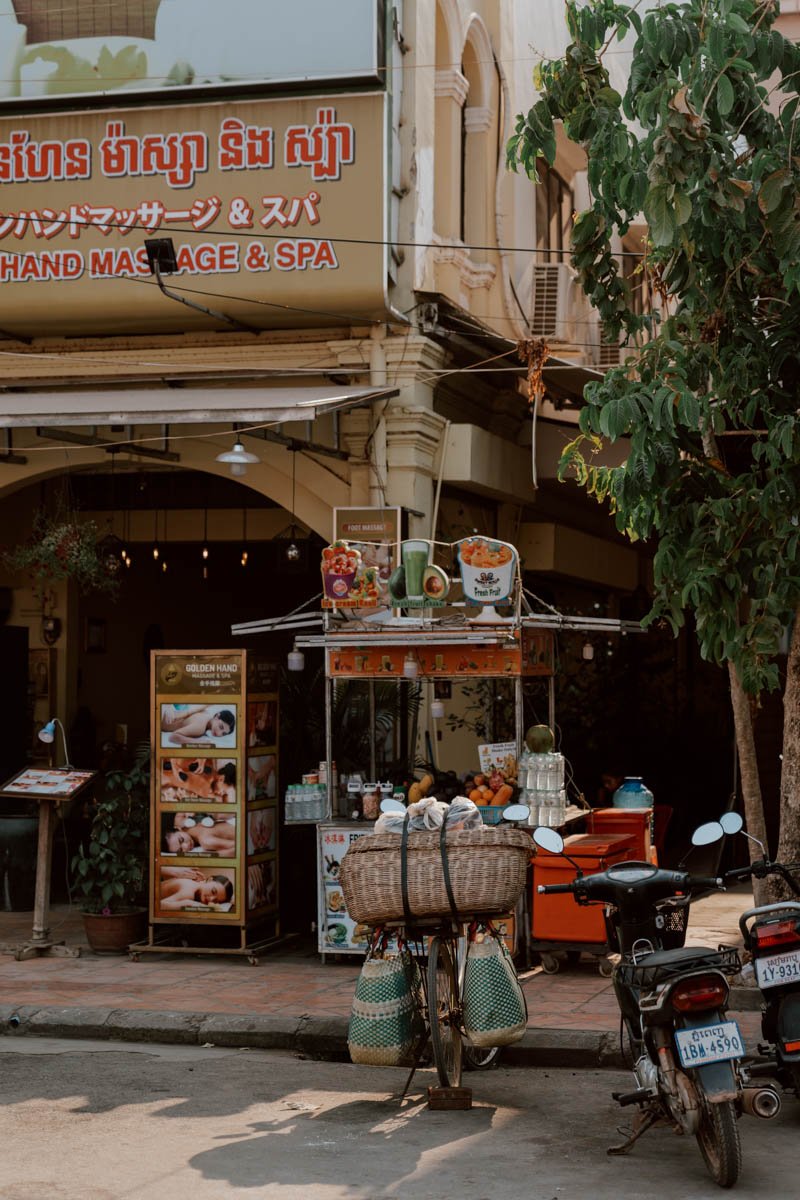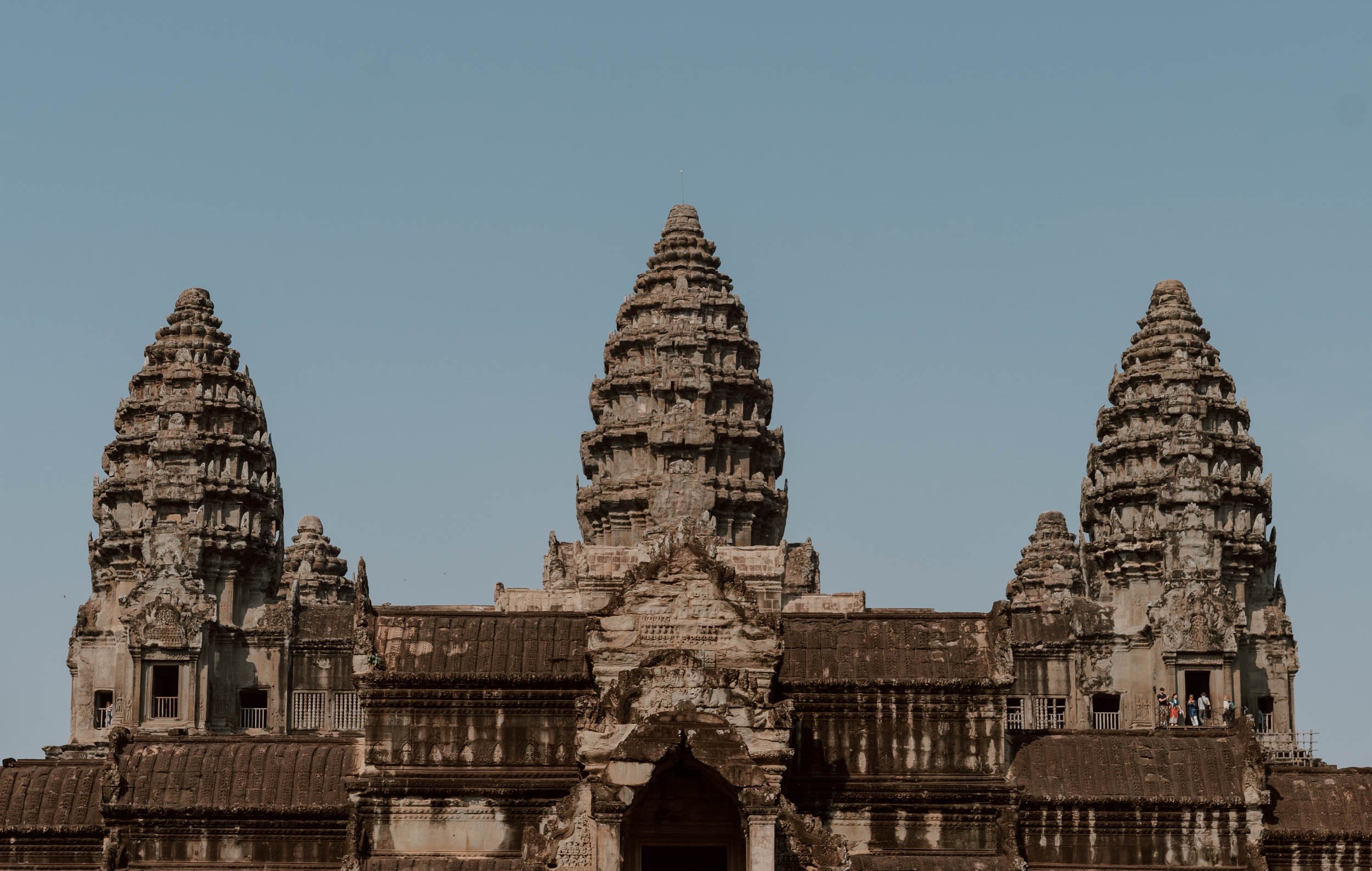As the gateway to Angkor Wat, the river town of Siem Reap acts as basecamp for thousands of travellers every day.
In this guide, we've shared the very best things to do in Siem Reap beyond Angkor Wat, alongside personal tips on where to eat and where to stay, essential advice on the real Siem Reap experience, and tips for onward transport connections to your next stop in Cambodia.
If you’re trying to make the most of your visit to Siem Reap, this is the post for you!
Updated December 2023
Don’t miss all our other Cambodia articles, start with these:
13 Wonderful Things to Do in Cambodia
Siem Reap essentials
Visit / Angkor Wat (naturally). Book a sunrise tour here.
Eat / Amazing veggie food at Banlle
Learn / How rats are saving lives at APOPO
Watch / The Phare Circus (buy tickets in advance here)
Drink / On the legendary Pub Street
Give / Back by supporting the city’s social enterprises
Wander / The many markets of Siem Reap
Join / A Khmer Cooking Class
Trip / Take a day trip to the floating villages, the Cambodian countryside or the Kulen Waterfall
Stay / Splurge at the gorgeous Treeline Urban Resort, opt for the mid-range Glow Inn Siem Reap or choose a hostel (Onederz is our pick of the bunch)
Is Siem Reap Worth Visiting?
Yes and no.
Of course, its proximity to one of the most famous and visited UNESCO World Heritage sites in the world means that it is going to feature on each and every single Cambodia itinerary. Whether you're travelling for a week, two weeks, six months, on a dirtbag budget overland adventure in south-east Asia or travelling in a style where you can splurge, you're going to spend some time in Siem Reap!
Angkor-adjacent tourism led, in the usual symbiotic manner, to greatly improved and increased accessibility by road and air to Siem Reap, thereby making it easier for yet more people to arrive each year. In the last decade, a dramatic shift in the number Chinese tourists and tours flying directly into Siem Reap has fuelled a second chapter in the town’s accelerated expansion story. In 2018, the Angkor Wat temples saw around 2.6 milllion visitors and it’s estimated that approximately 80% of Siem Reap's jobs are in the tourism industry (or depend upon it).
It was therefore inevitable that this town’s destiny was always going to be inextricably linked to the ebbs and flows of outsiders; personally though, we really weren't huge fans of what Siem Reap had become.
One half of Along Dusty Roads visited 15 years ago and the rate and nature of development, and the numbers of visitors, was staggering. The neon lights of the ever-growing, overly commercialised, overly hedonistic 'Pub Street' felt too much like a place trying to be another place for tourists. The visibility of the nefarious sex tourism trade in Cambodia was clearly growing in line with the increased footfall.
In short, central Siem Reap just didn't have the right vibe for us and the balance had veered far too much in one direction.
It’s not that it’s a bad place or a terrible place - it’s actually very pretty and enjoyable in parts by the river - but it just isn’t a place that we’d rush back to or proclaim as one of our favourite things to do in Cambodia.
Yet, it remains inevitable that every traveller who steps foot in Cambodia will spend time in Siem Reap - and that's exactly why we wrote this post. Our aim is to help you make the very best of your time there, rather than simply tolerate it or falsely heighten your expectations, and to accentuate the little gems and silver linings of the Siem Reap experience.
How Many Days Do You Need in Siem Reap?
And so, the key question is exactly just how much time should you spend in Siem Reap?
We promote slow travel everywhere we go, but we also balance that with the realities of destinations and itineraries. So, although we weren't huge fans of Siem Reap, the truth is that the ins-and-outs of transport there from Battambang or Phnom Penh (involving a 4 or 7 hour bus ride respectively), the necessary steps to ensuring you make it to Angkor Wat for sunrise, and the concentration of some great day trips and cultural activities in and around the town means that trying to squeeze everything in Siem Reap into just 48 hours really isn't a good idea.
In our suggested two and three week Cambodia itineraries, we recommend the following for Siem Reap:
Day One | Travel to Siem Reap from elsewhere in Cambodia (or fly in from elsewhere in Asia)
Day Two | Sunrise + full-day at Angkor Wat
Day Three | Another day at Angkor Wat, a rest day, or a day exploring and doing some of the best things to do in Siem Reap
Day Four | A rest day, an activity day, or depart Siem Reap for your next destination.
True temple enthusiasts will want to spend a few nights longer, but we think that most travellers should realistically plan to spend three or four nights in Siem Reap before moving on to their next stop in Cambodia. Any longer than that, and you’re simply cutting off time that you could be spending on the paradise Koh Rong islands in the south west or exploring more other, more enjoyable parts of Cambodia.
The Best Things To Do in Siem Reap
What is there to do in Siem Reap besides Angkor Wat? A lot.
Of course, we all go to Siem Reap principally to explore those iconic temples for a day or two, but the river town does actually offer up some excellent activities and day-trips to pass the time and get more insight into Cambodian culture, cuisine, and history before or after your time at the famous temples.
These are our favourite things to do in Siem Reap.
eat incredible plant-based food
Some of the best damn food you'll have in Cambodia is going to be here.
We kid you not.
The upside to Siem Reap becoming such a travel hub means that there are a smattering of really cool little cafes and restaurants around the town - and Vibe just about knocked our socks off. Its 100% plant-based menu offers up twists and fusions of Cambodian dishes as well as decadent global fare, alongside all the fresh & healthy smoothies, lunch bowls, juices, and salads you can shake a stick at.
Carnivores, vegans, veggies, and everyone in between will not regret eating here - we promise.
The cafe also supports the 'Good Vibe Foundation', a project aimed at feeding 10,000 school children in Cambodia with nutritious, healthy food.
this little street has a bunch of cool, hipster eateries and artisan shops.
Another excellent vegetarian restaurant we visited in Siem Reap was Banlle (maps), hidden away down a cool little sidestreet on the quieter side of the river (the better part of the town in our view). Again, it had plant-based travel favourites - including an AMAZING Tofu cheesy burger - as well vegetarian versions of lots of traditional Cambodian dishes.
Update 2023 | Unfortunately, Vibe is currently not open. We are leaving this section here however as we are aware that the owner is keen to re-open in the future (although perhaps under a different name, like Backyard Cafe in Phnom Penh).
Do A Cambodian Cooking Class
Hints of lemongrass, slurped noodles, and the kick of pepper are what comes to mind when we think back about our period of getting to know Khmer cuisine.
A cooking class always provides a wonderful snapshot into a country's culture and stories, as well as an opportunity to pass off stuffing your face as a cultural activity. And Siem Reap, given that most travellers will always have a day or two spare here, actually offers up the best chance to do a cooking class in Cambodia.
There are a variety of half-day classes available in the town centre or close by in the countryside to knockup your first fresh spring rolls, lok lak, or fish Amok curry. Three of the most popular and highly-rated cooking classes in Siem Reap include:
Khmer Cooking Class | This super popular and highly-rated 4-course class is capped to six people and takes place at a local’s home after picking up ingredients from the market. Book your spot here.
Siem Reap Small-Group Cooking Class | This very highly rated half-day small-group cooking class actually takes place in a rural village, but tuk-tuk ransport to/from Siem Reap is included. They offer morning or afternoon classes - book here.
Alternately, the above tour is also available on Viator.
Award-Winning Cooking Class Experience | Around since 2001, this is one of the city’s most established cooking classes during which you’ll cook multiples courses with a professional chef. The only downside is that class sizes are up to 20 people; this allows them to be competitive on price but some travellers may prefer a more intimate experience. Find out more here.
Evening Cooking Class | This option is ideal for anyone who perhaps is only in Siem Reap for a short while, is busy during the day but is still keen to do a cooking class.
You can find and book a few more options for cooking classes in Siem Reap here.
Understand the Barbarity of Landmines
Siem Reap, certainly in comparison to Phnom Penh, offers a chance to look back glowingly at a revered period in Cambodia's history, rather than confront bloody epoch of the Khmer Rouge.
However, in a country that suffered so many tragedies in the 21st century, you are never really that far away from a dark aspect of its past.
Due to decades of conflicts, including "a civil war, the brutal Khmer Rouge regime and genocide, American bombings, and Vietnamese occupation”, Cambodia remains one of the most landmined countries in the world. It's estimated that 4 to 6 million landmines were laid in the country, ultimately making it home to the world's highest ratio of mine amputees per capita. This is why it is not uncommon to see men, women, or children missing a limb during your travels here, and scores of people are still injured each year from the unknown number of landmines which remain scattered in the countryside's roads and fields.
Two museums in and around Siem Reap are essential to understanding the mental and physicals scars of the landmines, and the risks taken by those trying to clear them.
The first - The Cambodia Landmine Museum - tell the story of how so many mines came to be in the country and aims to educate visitors on the importance of clearing them.
The second - the newer APOPO (Anti-Personnel Landmines Removal Product Development) Visitor Centre - focuses on the history and impact of landmines on communities, as well as surprising members involved in clearance work. The 'hero rats', also known as Gambian Giant Rats (they're MUCH bigger than your average rat) are trained to use their acute sense of small to sniff out and clear landmines. If you're thinking right now that 'clearing' simply involves the rats detonating the mines by getting blown up by them, the good news is that they're too light to do this and so highly-valued for the work they do that killing one per mine wouldn't make much sense. Visitors to the centre are able to learn about their work, as well as watch a demonstration of their skills, at the Centre (APOPO’s animal welfare policies can be read here).
The Details | The Cambodia Landmine Museum is open from 7.30 am to 5.30 pm every day. Entry is $5 for adults and free for children under 12. The museum is unfortunately a little out of the way for most, requiring a tuk-tuk ride for 45 minutes to make the $20 round-trip. Visit their website for more information.
The Apopo Visitor Centre is open Monday to Saturday, 8.30 am to 5 pm. Visitors can take in a guided tour, Q + A, as well as watch a demonstration of from a member of the Hero Rat platoon for $5 per person. It's best to book tours in advance by emailing visitor.center@apopo.org - visit their website for more information. Note that the last tour begins at 4.30 pm
Visit Angkor Wat (Obviously)
Right, we won't labour the point here as this post is after all more about showing you all the things to do in Siem Reap before or after your Angkor Wat visit, rather than talking about the beautiful ruins themselves.
Instead, we've written this post - 7 Things To Know Before You Visit Angkor Wat (published soon) - so you can make your plans in advance!
If you want to know ticket prices, whether you should visit for 1 or 3 days, how to get there from Siem Reap independently, plus advice on how to make the most of sunrise at Angkor Wat, that post has all the answers for you.
For those that already know they want to join a sunrise tour (the best way to see the spectacular temples), this one is super popular and very highly rated.
Travel Tip // Those visiting Siem Reap who really want to do a deep dive into the rise and fall of the Angkor empire should consider visiting the Angkor National Museum in town before they visit Angkor Wat. It's open from 8.30 am - 6 pm, and entry is $12 for adults, $6 for children.
Support Social Enterprises (But Not 'Orphanages')
It’s essential for any visitor to Siem Reap, and Cambodia more generally, to understand that tourism here has both positive and negative outcomes. We have talked in greater details about the horrendous nature of the sex tourism trade in Cambodia, as well as the dark side of ‘volunteerism’ in orphanages’, in 23 Things To Know Before You Visit Cambodia.
What’s essential to know is that, though fewer in number than before, visits to orphanages in Siem Reap (both real and created) are still promoted as an altruistic and worthwhile activity here - and many well-meaning visitors continue to do it. However, the issue is that a corrupt and largely unregulated ‘orphanage tourism trade’ developed which was not in the interest or benefit of the children involved (and often only for the short-term gratification of the tourist). We’ve shared a few articles below which go into further detail on the rise of orphanage tourism and its negative outcomes in Cambodia, which are definitely worth a read:
Children Are Not Tourist Attractions | by ThinkChildSafe
Cambodia’s Orphan Business | by Al Jazeera
Why You Should Avoid Orphanage Visits in Cambodia | by GranTourismoTravels
Of course, this is not to deter you from trying to put your tourism dollars or attention towards doing some good! Issues arising from poverty and lack of access to resources affect many Cambodians, with the country amongst the poorest in the world (ranking 137th out of 185 countries for GDP per capita). Unfortunately, the money flowing in from the tourist economy doesn’t always have much ripple effect on improving that. Indeed, despite the boom in tourism in the region, Siem Reap remains one of the poorest regions in Cambodia.
The good news is that you can do a number of activities to support vulnerable, disadvantaged, or marginalised children and adults in Siem Reap in much better, more meaningful ways than orphanage visits, hand-wringing, or giving out money (also a no-no).
A number of social enterprise businesses and organisations exist solely to fund or directly provide training and education to improve the prospects of marginalised or at-risk children and adults. They’re also doing great work to change the narrative on how tourists and travellers can help, rather than hinder. We already mentioned the Phare circus, but a few other places to support in Siem Reap are:
New Hope Cambodia Restaurant (maps) | A small restaurant which provides professional training to young adults that expressinterest in the hospitality industry. The training program is a six-month commitment and the organisation then helps trainees find a full-time job placement in Siem Reap. We had a lovely dinner here during our stay in Siem Reap, and it’s set within the grounds of a school that provides free education, healthcare and family crisis care to ‘over 600 children from the poorest areas of Siem Reap’. Proceeds from traveller meals in the restaurant support both the training, education, and free medical checkups offered by New Hope Cambodia, the NGO which runs it. The restaurant (Google Maps) is open for lunch and dinner, but does require a 3 km tuk-tuk ride from Siem Reap.
Artisans Angkor (maps) | It aims to preserve and ‘revive ancient Cambodian Arts & Crafts while improving the lives of thousands of people living in rural areas through employment, training, and safe working conditions. They offer free guided tours at their Siem Reap showroom and workshop, just two minutes from the old market, and a free shuttle service to visit a silk farm outside the city too. Find out more details to plan your visit on their Facebook page.
Khmer Ceramics Fine Art Centre (maps) | The place we wish we had known about when we were in Siem Reap (basically, cook books, ingredients, and pottery or photography for our flat are our version of souvenirs), the small centre offers up beautiful pieces and puts profits back into the research and preservation of Khmer pottery, as well as support for artisans.
They also offer this 2-hour Khmer pottery class. Find out more on their website.
Footprint Cafe | A cool little social-enterprise cafe that opened its doors in 2016 with support from the University of Cambridge. It provides training and skills development and ‘100% of net profits given as grants back to the local community as educational and entrepreneurial grants decided by a local committee’. The cafe is on street 26, a 50 metre walk from the river (Google Maps). You can read out about the cafe’s aims on its website here.
If you know of any other social enterprises in Siem Reap doing good work which travellers can visit and support, let us know in the comments and we’d be happy to include them!
A Day Trip To The Floating Villages
Tonlé Sap, the largest lake in south east Asia, lies just outside Siem Reap and its banks are home to many villages - often referred to as the ‘floating villages’. The water shapes their lives, with small-scale fishing a key industry and waterways channels bringing children to school and people to work.
There are a bunch of day-trip tours from Siem Reap to several of the floating villages (including Kompong Khleang, Kompong Phluk, Chong Kneas, and Meychrey), and it’s essential that you act in a respectful and considerate way when exploring these communities.
Chong Kneas is mentioned as the least authentic village to visit, but sees a lot of tourist traffic due to its accessibility. You can compare, read reviews and book in advance for the following popular tour options:
Sunset tour of floating village Kampong Phluk | This is by far the most popular tour option, with thousands of excellent reviews. The small-group tour lasts six hours, and includes a visit to the village of Kampong Phluk before heading out on to Tonle Lake. You can find out more or book here.
Tonle Sap Lake Floating Village & Sunset Dinner Tour | More expensive than the above option due to the sunset dinner that’s provided. This tour is also very popular though! Find out more or book here
If you’d prefer to visit these two destinations as part of a private tour, we recommend taking a look at this one.
It’s also possible to combine your visit to the floating villages and Tonel Lake with other popular activities in and around Siem Reap:
Floating village sunset boat & countryside jeep tour (with free drinks)
Countryside bike tour plus boat trip to the floating villages (includes lunch)
Where To Stay in Siem Reap
Given that Siem Reap see thousands of visitors arrive and depart each day, the number of hostels and hotels catering to every budget and travel style is quite intimidating.
We've done the hard work for you and whittled down a selection of the very best accommodation in Siem Reap for your trip. Given its popularity as a destination, it's recommended to book ahead, especially in the peak season of November to March.
The Best Hotels in Siem Reap | The Six Best Hostels in Siem Reap
If you’re just looking for a quick recommendation however, our top picks include:
Hostels | Onederz and Lub d are our top picks, but for a party hostel head to Mad Monkey
Good Value Hotels | Hillocks Hotel & Spa, Glow Inn Siem Reap, Babel Guesthouse
Luxury or Boutique | Viroth's Hotel, Angkor Village, Treeline Urban Resort
A Night at the Cambodian Circus
Cambodia’s answer to Cirque du Soleil, Phare Circus is performance art with ethics and impact.
Formed in 1994 by nine refugees of the Khmer Rouge regime, it first found its home in Battambang, before success allowed a second theatre to be opened here. Telling uniquely Cambodian stories through theatre, music, dance and acrobatics, these exceptionally accomplished young performance artists entertain as well as educate - with all proceeds supporting a number of social initiatives for the local communities.
Today, nearly 20 years since those nine individuals founded an association and a school (providing traditional education, as well as education in the arts), they have more than 1,700 attendees, offering a place where students can learn, and graduates can earn a good wage; money that will remove them from poverty and freedom to pursue a better life.
Absolutely everyone will love a night at the Phare Circus, but if you're a family in Cambodia, you definitely don't want to miss this show.
(No animals are involved in this circus - a very good thing indeed - instead it's about theatrics, live music, laughs, acrobatics, and spectacle).
The Details | The circus is 2-3 kms outside the centre of Siem Reap (Google Maps), so it’s best to take a tuk-tuk there and back. The performance is at 8 pm every night, all year round. It's essential to book your ticket in advance for the Phare Circus in Siem Reap as it often sells out. This can be done via the official website, but if there are none available for your dates, you can usually secure tickets on Viator for around the same price.
There are three classes of ticket for the 3/4 circle area:
Section A. Reserved seating in the front half of the central area which provides the best views
Section B. Open seating in the rear half of the central seating area
Section C. Open seating in the two side areas with partially obstructed views likely. Important to note that in these seats you will mostly be seeing the performance from behind or from the side as the stars and screens are directed toward the central seating areas.
We went for the Section C seats due to the price, but unfortunately arrived after the handful of unobstructed seats were already taken, meaning pretty bad views for the duration of the performance. Honestly, we wouldn’t really recommend these seats unless you’re on a tight budget, especially if you’re keen to take photos or have the best experience of the show. If you do go for Section C seats though, just try to get there super early so you can get a half-decent one!
have A Drink on Pub Street
We've never visited Thailand, but got the distinct impression that Siem Reap's Pub Street was trying to create a little of the Bangkok nightlife vibe here (further research since has confirmed that initial view). Lit up by neon, it's at the heart of the touristic centre of the town but the whole atmosphere and vibe it both creates and promotes was a big reason that we wouldn't recommend lingering in Siem Reap for much longer than necessary.
It's ironic, because the rationale behind Pub Street’s expansion was almost certainly to make Siem Reap more of a destination in and of itself, rather than just a place you come to solely in order to go somewhere else.
Originally contained to just street number 8, it has grown to take over the whole block by the old market. There are a bunch of restaurants, pubs, nightclubs, and live shows but the whole thing just felt like an artificial creation of fun and hedonistic potential for western tourists, rather than anything actually enjoyable.
After a long day exploring temples, or in the downtime days afterwards, you may meet some great people there, have a fun night out and hook-up, or get a good meal and lots of cheap booze, but you may also not like it very much. However, most evening plans will gravitate in and around Pub Street and it’s pretty hard to avoid passing through it a few times.
We know we may sound a little miserable here, but long-time readers will know that we are all about a good night out with lots of gin. However, places like Pub Street in Siem Reap just ain't what we travel for - and the gaping juxtaposition offered between it and what we all travel to Siem Reap to visit was not lost.
Travel Tip // A better place for a a spot of people-watching with a cold beer or cocktail is on one of the bars or restaurants on the corners facing the central market. We also really liked Wat Bo Road, Street 26, Street 27 (all next to each other across the river from Pub Street and the tourist centre) which had more chilled out traveller bars and restaurants, as well as cool little truck serving cheap cocktails to a handful of tables on the pavement.
Escape To The Cambodian Countryside
Some of our happiest memories of our travels in Cambodia came, unsurprisingly, out on the dusty roads of the countryside. They offer fresh air, different perspectives away from the tourist bubble, wonderful rice field landscapes, and an insight into the lifeblood of everything.
The vast majority of the Cambodian population lives in the countryside too, so venturing out here gives a great glimpse into how many locals beyond the urban centres live their lives in wooden houses on stilts with small plots of land and a few prized animals shaping the daily rhythm.
The best way to experience the Cambodian countryside is slowly on two wheels with slightly questionable suspension! It’s possible to rent your own bicycle or motorbikes in Siem Reap to get out and explore independently, or you can take a tour on two wheels. There are a few places offering quad bike tours through the countryside, but for us this sort of misses the point and is a pretty obnoxious way to do it.
Personally, if you’re not travelling on a super tight budget, we think joining a tour with a local guide is the best option; this allows you to have some meaningful contact with locals, many of which don’t speak English. This five hour countryside bicycle tour is by far the most popular option available to book online and in advance, with hundreds of excellent reviews.
For an alternative experience, you could join this tour which aims to have you out cycling for sunset.
Get Lost in the Markets
To spend time in south east Asia is to spend time getting lost in local markets - and though the two markets in Siem Reap are a little more geared towards tourists than usual, they still offer serendipitous little snapshots into Cambodian habits and lifestyles.
Psar Chas (also known as the ‘Old Market’), right by the river and a couple of blocks from Pub Street, is a buzzing place open day and night offering up food, jewellery, clothing, bric-a-brac, and everything in between as well as the standard souvenir offerings. Definitely worth your time, especially if you aren’t going to be in Asia for long and want to get a sense of place. You can find the market on Google Maps.
The 200 bamboo huts of Angkor Night Market off of Sivatha Boulevard are much more tourist-focussed, and therefore less interesting. This is supposedly the original night market in Siem Reap but it can actually be pretty difficult to tell these days which is which as there are so many stalls set up on the streets each night around Pub Street - for example, Noon Night Market is just down the road from the Angkor Night Market. You can get cheap souvenirs, decent-standard knock-offs of brands, and all the elephant pants you can shake a stick at! You can find the Angkor Night Market on Google Maps.
Across the river, the Made In Cambodia Market offers up an opportunity to buy some souvenirs which have been crafted and produced in Cambodia, rather than shipped in from China or Vietnam. It will be a little more expensive for souvenirs or clothes, but they’re of a better quality and more unique. Find the Made in Cambodia Market on Google Maps.
A Pamper Day
You are on holiday after all!
If you’re exhausted after an early wake-up for sunrise at Angkor Wat and a full-day exploring its temples on foot under the hot sun, then you shouldn’t feel too bad if you simply don’t have the energy or inclination to do any day trips from Siem Reap or other things in the town.
Indeed, after our own Angkor visit, we opted to spend a big chunk of the following day camped in BIOLAB Coffee & Office drinking excellent coffee, catching up on work and editing photos (it’s a fantastic spot for digital nomads in Siem Reap by the way).
Siem Reap is very well set up for a Netflix n’ chill pampering day. So, simply book a hotel or hostel with a pool, head out for a 60-minute full-body massage for $12 or so (these are available all over the town - just make sure it’s a ‘legit’ massage place), plan the next day or two of your Cambodia itinerary, feast on some amazing food and savour a pick-me-up happy hour cocktail.
A Temple Visit (No, Not Those Ones Again!)
Wat Preah Prom Rath is a beautiful Buddhist temple set in idyllic grounds where (respectful) visitors are welcome. Although just a short walk from the centre of Siem Reap, its serene peacefulness feels like a world away and is the place to escape for some curious contemplation.
The monks here also look after stray dogs and cats, and welcome dog or cat food donations to support them!
You can find the temple on (Google Maps) - entrance is free, but contributions are welcomed.
Travel Tip // When visiting any Buddhist temple, as well as various other sites in Cambodia, it’s essential that men and women dress modestly. Remove your shoes, cover your back, chest, and shoulders, and wear something which goes below the knee. You also need to interact properly around Buddhist monks. Find out more in 23 Things To Know Before in Cambodia.
take A Day Trip To Phnom Kulen National Park
There really aren’t many hiking opportunities in Cambodia, but if the hustle and bustle tourism and traffic of central Siem Reap is proving a bit too much then a day trip to the national park will be a panacea.
Home to the holy Kulen mountain, you can take a dip in a few waterfalls, gaze out on the countryside, visit the famous Reclining Buddha, and a manageable hike along the 1000 Lingas river towards the summit.
It's 48 kms from Siem Reap, and this highly rated full-day Phnom Kulen tour includes an English speaking guide, hotel pick-up, all transport.
Siem Reap Transport
How To Get Around Siem Reap
The epicentre of everything is on the western side of the river around Pub Street and the Old Market. We were based across the river in the Wat Bo area, which is quieter and much less of a tourist hub. Aside from your transport to and from Angkor Wat, getting around central Siem Reap is pretty straight forward with everything in walking distance whether you’re on the west or east side of the river.
If it's too hot, too far, too dark, or feels unsafe, then simply get a tuk-tuk for a few dollars - the Pass and Grab apps are also popular tuk-tuk hailing apps (like Uber essentially). Find out more in 23 Things to Know Before You Visit Cambodia.
How To Get To Siem Reap
Recent improvements in road and flight access have contributed to the growth of Siem Reap in the last decade, and it's now pretty easy to reach from elsewhere in Cambodia.
Siem Reap International Airport (SRIA), 8km outside the city centre, hosts internal flights as well as a growing number of routes from Asia; this means quite a few of you may actually start your Cambodian adventure in Siem Reap.
From the airport, you can take a tuk-tuk ($9) or taxi for ($10) for the 20 minute ride into the centre. You can also book private airport transfer to your hotel with a tuk-tuk or taxi in advance here.
From Phnom Penh | You can opt for a 6-7 hour bus, 1 hour flight, or a 5 hour private transfer.
You can check times and book bus tickets etc on CamboTicket and BookMeBus, or book a private transfer between the two cities here but if you’re making this journey, be sure to read our guide on How To Get From Phnom Penh To Siem Reap.
From Battambang | It's a straightforward 3-4 hour bus journey - we recommend BookMeBus for viewing up-to-date schedules and booking your bus tickets in Cambodia.
From Koh Rong or Kampot | Unless you fly from Sihanoukville, we don't recommend going direct to Siem Reap from either of these two destinations in the south west of Cambodia. But feel free to read our guides to them to help plan your visit - 9 Things To Know Before You Visit the Koh Rong Islands & A Traveller’s Guide To Kampot.

